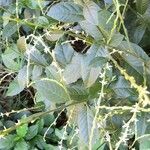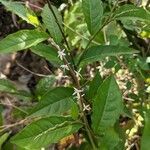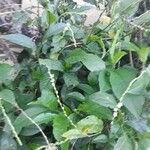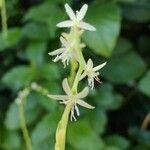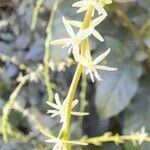Tall herbs, often woody at the base, with slender sometimes angled stems, to 5-10 dm. tall, with a strong odor of garlic. Leaves elliptic to obovate, the apex acute or acuminate, often mucronate, the base narrowed, 5.5-16.0 cm. long, about 2-6 cm. broad, slightly pubescent; petioles 1.5-2.0 cm. long. Inflorescence in slender usually sparsely flowered racemes 15-40 cm. long; pedicels up to 1 mm. long. Tepals white or greenish-white, sometimes pale pink, often basally pubescent, about 3-5 mm. long. Stamens 8, free, up to 3 mm. long. Ovary 4-uncinate, the hooks becoming elongate and quite prominent in fruit. Fruit linear, 8 mm. long.
Stems erect, 3-20 dm, pubescent to glabrate. Leaves: stipules 2 mm; petiole 0.4-2 cm; blade elliptic to oblong or obovate, to 20 × 7 cm, base acute to cuneate, apex acuminate or acute to obtuse or rounded. Inflorescences often drooping distally, 0.8-4 dm; peduncle 1-4 cm; pedicel 0.5-2 mm. Flowers slightly imbricate to rather remote; sepals white or greenish to pinkish, linear-lanceolate to linear-oblong, 3.5-6 mm; ovary tomentose. Achenes striate, subtended by persistent bracts and perianth, ± appressed to rachis, 8-12 mm. 2n = 36, 72.
Erect, ½-1½ m high; stem thin, hairy in the upper part. Leaves elliptic-oblong or slightly obovate, from an acute base, with a narrowed or acuminate, acute, obtuse or rounded apex, wavy, pubescent on the main nerves above, glabrous beneath, 6-17 cm by 2½-6½ cm; petiole ½-1½ cm. Racemes spiciform, often nodding at the apex, rather lax, 10-40 cm long. Bracts ovate, acutely acuminate. Pedicels ½-1 mm. Perianth during anthesis 3-4 mm long, afterwards up to 6 mm. Stamens 6-8, erect. Fruit-spines 4, ± 3 mm long.
A shrub. The stems are 30-200 cm tall. They can be hairy. The leaves are narrowly oval and 20 cm long by 7 cm wide.
